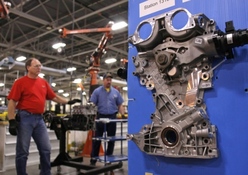Factor production in US falls below expectations
US factory production, a gauge of economic activity, dipped 0.1 per cent in May after having gained 1.0 per cent in April, the second month of contraction in the last three months, the Federal Reserve said Friday releasing the data for last month.

Factory production shrank 0.4 per cent last month, and "partially reversed a large increase in April," the Federal Reserve stated.
Outside of manufacturing, the output of mines advanced 0.9 per cent in May, while the output of utilities rose 0.8 per cent.
At 97.3 per cent of its 2007 average, total industrial production in May was 4.7 per cent above levels during corresponding month last year.
Analysts polled by Reuters had expected industrial production to rise 0.1 per cent.
The slackening US recovery and a worsening debt crisis in Europe have increased expectations of a further easing of monetary policy by the Fed, although economists are divided on whether the central bank will act when it meets on Tuesday and Wednesday.
Coming on the heels of reports indicating continuing slow growth in hiring by US employers, contraction in retail sales in May and rise in new applications for jobless benefits, the scenario is causing some concerns.
Capacity utilization for total industry declined 0.2 percentage point to 79.0 per cent, a rate 1.3 percentage points below its long-run (1972--2011) average.
In May, manufacturing output decreased 0.4 per cent after having advanced 0.7 per cent in April. The index for manufacturing in May was 5.2 per cent above its year-earlier level. The factory operating rate moved down 0.4 percentage point to 77.6 per cent, a 1.2 percentage points below its long-run average.
The production index for durable goods declined 0.5 per cent in May after having posted a gain of 1.4 per cent in April. Durable goods industries with decreases of more than 1 per cent in May included nonmetallic mineral products, primary metals, motor vehicles and parts, and furniture and related products.
The largest increase among major durable goods industries was for wood products, which moved up 1.0 per cent, and smaller gains were recorded by fabricated metals; electrical equipment, appliances, and components; and miscellaneous manufacturing.
Capacity utilization for durable goods manufacturing was 78.0 per cent, a rate 5.0 percentage points above its year-earlier level and 0.9 percentage point above its long-run average.
The production of nondurables decreased 0.2 per cent in May, its third consecutive month without a gain. The index has risen 1.4 per cent in the last 12 months; capacity utilization edged down 0.1 percentage point in May to 78.4 per cent, a rate 2.5 percentage points below its long-run average.
Despite production increases in May of about 1 per cent for apparel and leather and for petroleum and coal products, and a smaller gain for printing, decreases in all of the other major nondurable goods industries led to a decline in the overall index, the data showed..
Production in the non-NAICS manufacturing industries (logging and publishing) dropped 1.3 per cent in May after having risen 0.6 per cent in April.
In May, mining output advanced 0.9 per cent, primarily supported by gains in crude oil extraction and coal mining. Capacity utilization for mining moved up 0.7 percentage point to 89.2 per cent, a rate 1.9 percentage points above its long-run average.
The output of utilities increased 0.8 per cent after having jumped 5.3 per cent in April. The operating rate for utilities rose 0.5 percentage point in May to 76.5 per cent, a rate 9.8 percentage points below its long-run average.
Capacity utilisation, a measure of how fully firms are using their resources, slipped to 79.0 per cent in May from 79.2 in the prior month.
Officials at the Fed tend to look at utilisation measures as a signal of how much "slack" remains in the economy - how far growth has room to run before it becomes inflationary.
The report "is another illustration of how rapidly the economy has lost momentum after a very strong start to the year," said Paul Ashworth, an economist at Capital Economics, in a note to clients.
Ashworth noted that average manufacturing output rose in the past three months at only a 2.4 per cent annual rate.
He blamed the European financial crisis and slower growth in China, India and other emerging markets for hurting U.S. exports of factory goods.
Source: US News.Net
- 524 reads
Human Rights
Fostering a More Humane World: The 28th Eurasian Economic Summi

Conscience, Hope, and Action: Keys to Global Peace and Sustainability

Ringing FOWPAL’s Peace Bell for the World:Nobel Peace Prize Laureates’ Visions and Actions

Protecting the World’s Cultural Diversity for a Sustainable Future

Puppet Show I International Friendship Day 2020

